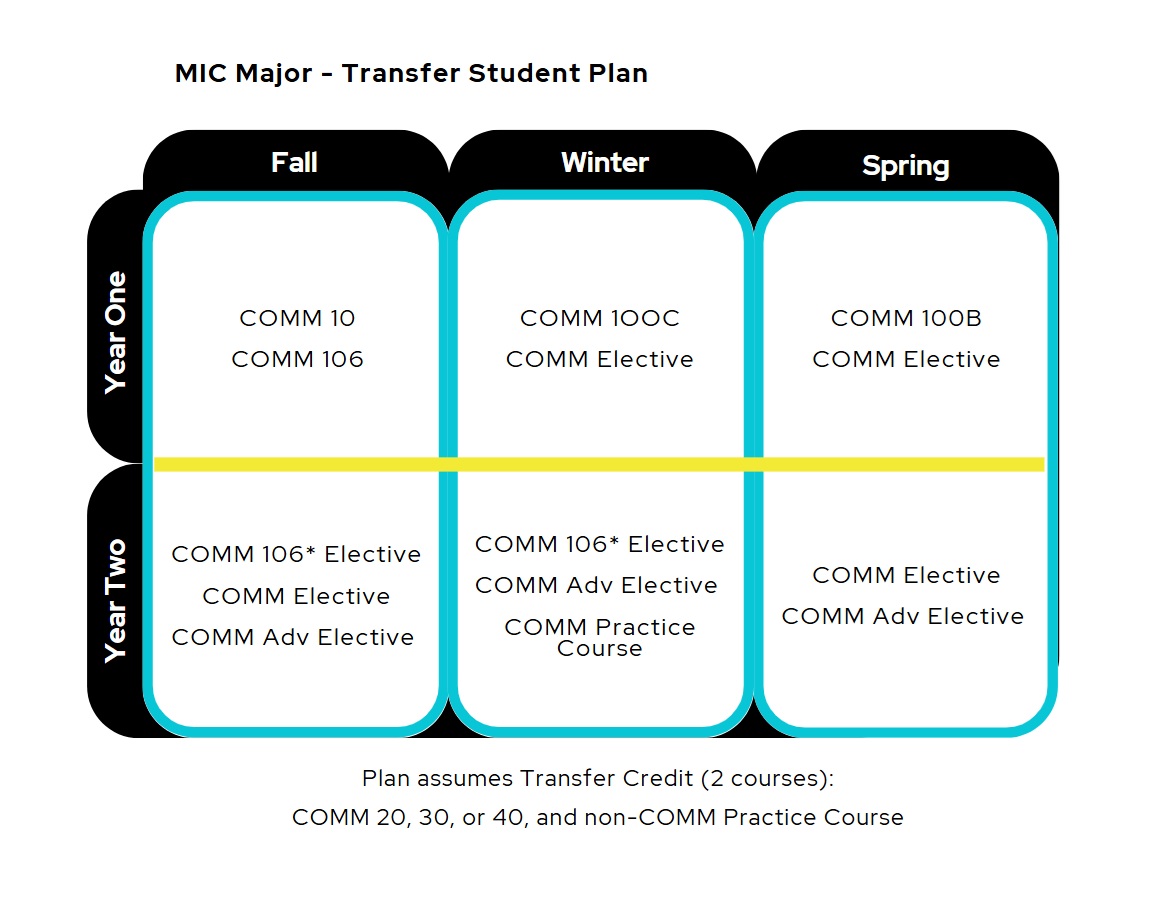The Media Industries & Communication Major

The Media Industries & Communication (MIC) major provides students with the historical and theoretical background and critical and practical skill sets to analyze an increasingly complex media and communication landscape. By focusing on media industries–as opposed to just media aesthetics, artistic forms, and cultural appreciation–we provide students with a relevant, professionally legible, and dynamic degree.
We welcome aspiring media practitioners (filmmakers, performers, musicians, journalists, etc.) but also those who aspire to work in media and culture as marketers, managers, agents, lawyers, executives, policy analysts, HR professionals, and more. Our conception of media, culture, and communication is expansive, and includes not just traditional forms like film, television, news, and music, but also: digital culture like internet fads, streaming video, and message boards; promotional media like advertisements, product and destination marketing, and crisis communication; and the production of live media events and experiences like tourism, pop-up brand activations, and tabletop role-playing games.
MIC requirements are similar to those for the general Communication Major, but add skills-oriented, practice-based courses, as well as courses focused on the critical and historical analysis of specific industries such as film, television, video streaming, internet, tourism, data & AI, journalism, and advertising. The MIC Major is designed to accommodate students who are interested in double-majoring, minoring, and/or exploring alternative learning opportunities including internships, study abroad, and more.
Why Should I Major in Media Industries & Communication?
In 2022, the film & television industry directly employed 930,000 people in the U.S. collectively earning more than $100 billion (an average salary of more than $110K/year). Publishing and journalism employ close to 100,000 Americans, while the advertising and PR business boasts nearly 500,000 more jobs. A significant portion of these positions–which seek knowledge workers who are well-educated and think creatively and critically–are located in Southern California.
But the media and communication industries are actually much broader. The old divisions between film, television, gaming, publishing, and technology are disintegrating. Content migrates from television to online publications to books to theme parks and back, with workers shifting between production, marketing, and business. Our major reflects this porous nature of contemporary media by covering multiple media, cultural, and tech industries.
Our program, however, is NOT pre-professional and does NOT offer vocational training. Instead we prepare students for careers in the broadest sense, by providing the critical tools necessary for confronting a dynamic job market. We know how quickly media technologies change, how volatile the cultural marketplace is, and how complex communication and nonprofit sectors can be. We aim to prepare you for these challenges for the long term, by supporting your transformation into informed and media literate citizens, responsible and imaginative creators, and ethical future leaders in the fields of media, communication, technology, and culture.
In the 21st century, the media landscape has grown exceedingly complex; it is more technologically advanced, more financialized, more global in nature, and more deeply embedded within political and economic struggles. It is more important than ever not only to understand different types of media content, but also to grasp the entirety of the system that produces, distributes, and consumes them. This means locating power and flows of power within industries and across governments, explaining how economics, legal systems, and policy shape popular culture, and describing the impact of mass communication on identity formation, representational practices, and the formation of institutional and democratic norms.
So in addition to learning the basics of textual analysis, semiotics, and media history (traditional components of media programs), MIC Majors will learn about media economics, media law, media technology, algorithmic culture, platform infrastructure, communication regulation, globalization, creative labor, and worker- and organizational cultures (the elements that make our program unique).
- Identity. How both media representations and media systems construct racial, ethnic, and gender identity, impacting social experience, practices, discourses, and expectations as well as social groups, classes, and relations.
- Social Media & Advertising. How to discern and describe the social meaning of advertising and evaluate claims about the content, forms, and technologies of social media. How to use personal ambivalence about these forms to understand both the pleasure they provide as well as their exploitative structural tendencies.
- News Media & Misinformation. How contemporary publishing both sustains and undermines democratic life and culture via an understanding of the embeddedness of news media practices in social, economic and political conditions.
- Labor & Working Conditions. How to recognize and respond to the changing shape of work in media industries that are increasingly reliant on flexible, freelance and “spec” labor, with widespread effects on organizational culture, unionism and labor relations, and workers’ experiences, working conditions, and professional mobility. Our students will enter these workplaces equipped to advocate for themselves, navigate the complexities of creative collaborative workspaces, and recognize the value of their own labor and that of the collective.
- Business & Entrepreneurship. How to navigate the contemporary media landscape as a leader and/or a worker in ways that are ethical and oriented toward social justice. How to recognize the often asymmetric relationships between the rights of laborers, the public good, and the established economic imperatives and legal practices of media corporations.
16 REQUIRED COURSES
All major courses must be taken for a letter grade. *Core Courses marked with an asterisk must be taken at UCSD and may not be petitioned for substitution.
2 Lower Division Courses
- COMM 10. Introduction to Communication*
Choose ONE course from the following:
- COMM 20. Media Analysis
- COMM 30. Digital Media Literacy
- COMM 40. Introduction to Promotional Communication
3 Required Upper Division Courses
- COMM 106. Introduction to Media Industries*
Choose TWO courses from the following:
- COMM 100A. Communication, the Person, and Everyday Life*
- COMM 100B. Communication, Culture, and Representation*
- COMM 100C. Communication, Institutions, and Power*
2 Required Industry Electives*
- 106B: Streaming Media
- 106D: Data & AI Industries
- 106F: Film Industry
- 106G: Tourism
- 106I: Internet Industry
- 106M: Advertising & Society
- 106N: Journalism and the News Industry
- 106V: TV Industry
7 Communication Electives
- Three courses numbered COMM 160-190
- Four courses numbered COMM 101-190
2 Practice Courses
- At least ONE practice course must be taken within the Communication Department. Many of the permitted practice courses fill other college and university requirements.
Download Media Industries & Communication Major Requirements Checklist
Download Media Industries & Communication Major Practice Course List
Petition to Count Transfer Coursework Towards the COMM 20/30/40 Requirement or the non-COMM Practice Course Requirement:
- Complete an Undergraduate Student Petition (one for each course to be considered), including:
- The name of the institution where the course was completed
- The title of the course, the number of units, and term/year completed
- In the "Request" section, note: "Request to consider previous community college course for the Media Industries requirement of [COMM 20/30/40 or non-COMM Practice course]."
- Attach the course's syllabus, which must include the texts/readings required
- Submit the completed petition to us via the COMM UG Petition Form. The department's Faculty Advisor will review it and you will be notified of the result via the VAC.
Petition to count courses outside of the Communication Department towards the MIC major:
- Students may petition a maximum of 2 upper division courses taken outside of the department to count towards the major's Intermediate Elective requirement. (Examples: EAP / Study Abroad, courses in other UCSD departments, and/or courses at other UC campus).
- These courses must be upper division (numbered 100+), at least 4 units, and must be passed with a C- grade or higher.
- Courses must be related to our department's curriculum and oriented towards communication theory or production skills (as opposed to business/management related best practices).
- Complete an Undergraduate Student Petition, including:
- the title of the course,
- the number of units,
- the course description (from the course catalog),
- how the course relates to the major
- attach the course's syllabus, which must include the texts/readings required
- Submit your completed petition via the COMM UG Petition Form. The department's Faculty Advisor will review it and you will be notified of the result via the VAC.
Petition to count Academic Internship Program (AIP) 197 towards the MIC major:
- Students may petition a maximum of one AIP 197 (4 units) towards the major's Intermediate Elective requirement. The AIP course must be supervised by a COMM Faculty Mentor.
- Once the AIP 197 grade is posted to the your Academic History, complete an Undergraduate Student Petition. Include in the body of the petition:
- the name of the company/organization,
- the start and end date,
- the name of your AIP Faculty Advisor (must be a member of the Communication Department faculty).
- attach a copy of your AIP Learning Agreement.
- Submit your completed petition via the COMM UG Petition Form. The department's Faculty Advisor will review it and you will be notified of the result via the VAC.
Petition to count COMM 198 (Directed Group Study in Communication) or COMM 199 (Independent Study in Communication) towards the MIC major:
- Students who enroll in COMM 198 or 199 may petition to count one of these courses (4 units max) towards the major's Intermediate Elective requirement.
- To enroll in these courses, students must first submit a Special Studies Course application. These independent study courses are only offered for a P/NP grade.
- Complete an Undergraduate Student Petition:
- detail in the body of the petition the work completed in the course
- include the name of Communication Department Faculty Mentor
- Submit your completed petition via the COMM UG Petition Form. The department's Faculty Advisor will review it and you will be notified of the result via the VAC.
The MIC Major courses below must all be taken in residency at UCSD. They cannot be transferred or taken abroad.
- COMM 10: Introduction to Communication
- COMM 100A (Communication, the Person, and Everyday Life), COMM 100B (Communication, Culture, and Representation), or COMM 100C (Communication, Institutions, and Power)
- COMM 106: Introduction to Media Industries
- All COMM 106 Industry Electives
- 3 Advanced COMM Electives (COMM 160-190)
- 2 COMM Electives (COMM 101-190)
- COMM Department Practice Course
Please see your College Advising Team regarding non-major residency requirements.
CONGRATULATIONS ON YOUR ADMISSION TO UCSD AND WELCOME TO THE DEPARTMENT OF COMMUNICATION!
We invite you to read through our information and guidance on our Newly Admitted Students webpage.


